Death and Hope
A multi-
One emotion is constant, however: hope. It appears in many ways: hope for life after death, hope that the world is better because someone lived, hope that death occurred for a reason, hope that survivors rededicate themselves to whatever they deem meaningful in life.
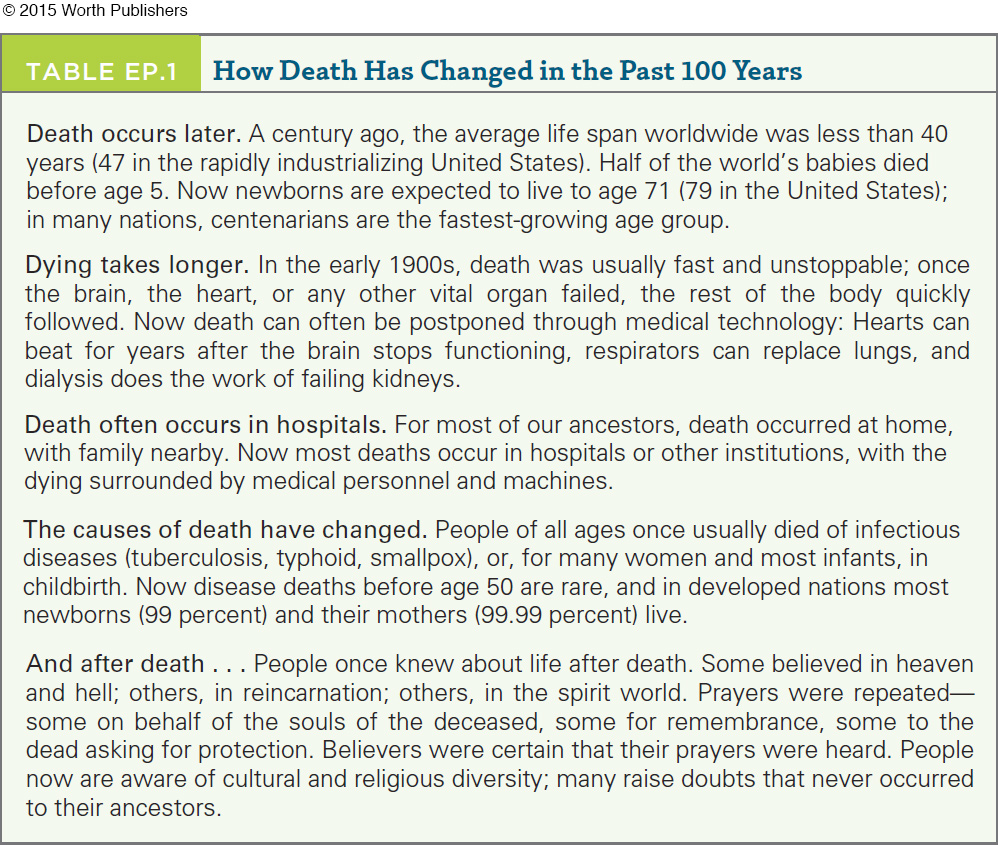
Cultures, Epochs, and Death
Few people in developed nations have witnessed someone die. This was not always the case (see Table EP.1). If someone reached age 50 in 1900 in the United States and had had 20 high school classmates, at least six of those fellow students would have already died. The survivors would have visited and reassured friends who were dying at home, promising to see them in heaven. Almost everyone believed in life after death.
Now few die before old age, and if a young person dies, most often it occurs too quickly to say goodbye. Ironically, death has become more feared as dying has become less familiar (Carr, 2012). Accordingly, we begin by describing traditional responses when familiarity with death was common.
ANCIENT TIMES Paleontologists believe that 100,000 years ago the Neanderthals buried their dead with tools, bowls, or jewelry, signifying belief in an afterlife (Hayden, 2012). The date is controversial: Burial could have begun 200,000 years ago or more recently—
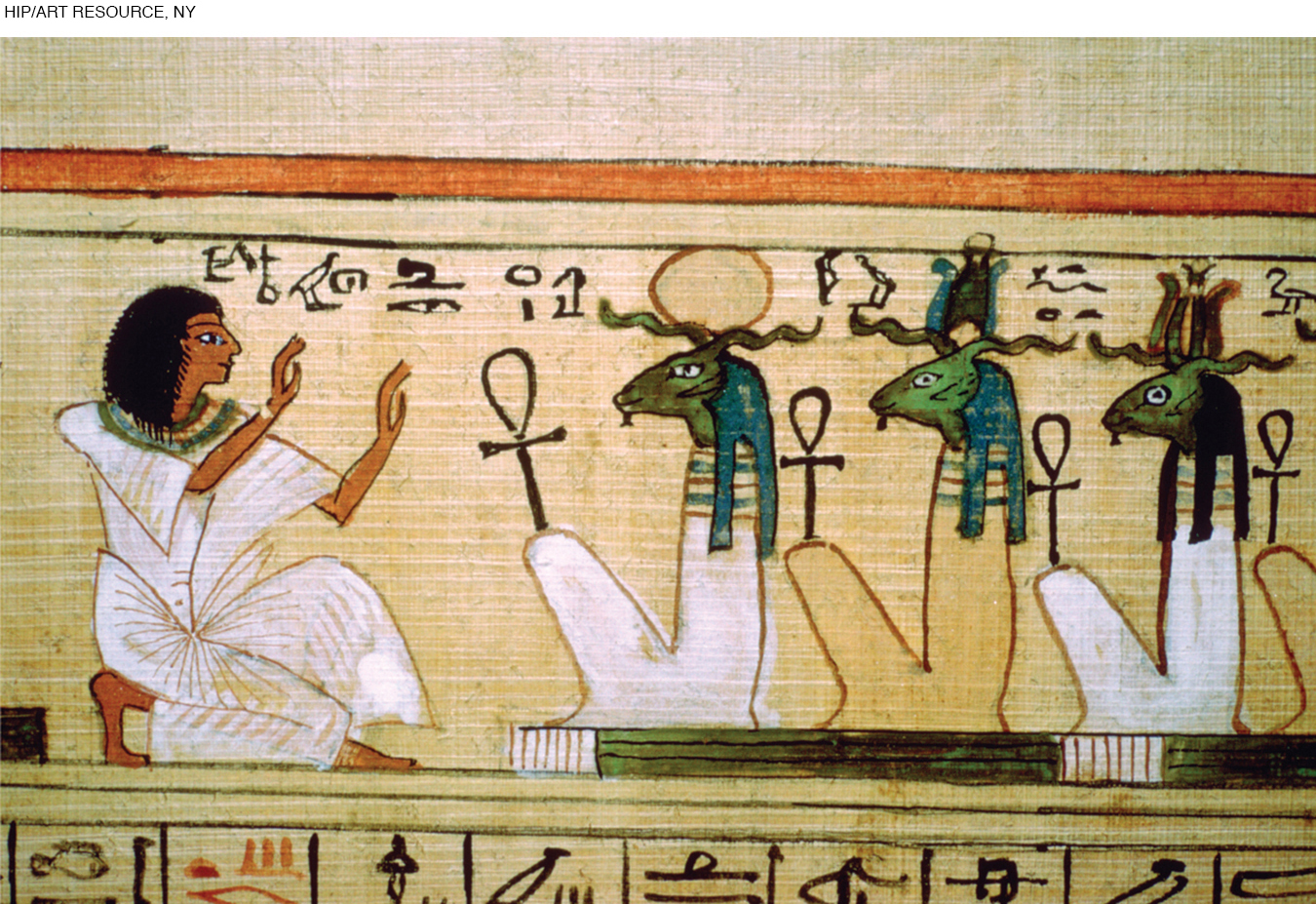
The ancient Egyptians built magnificent pyramids, refined mummification, and scripted instructions (called the Book of the Dead) to aid the soul (ka), personality (ba), and shadow (akh) in reuniting after death so that the dead could bless and protect the living (Taylor, 2010).
The fate of dead Egyptians depended partly on their actions while alive, partly on the circumstances of death, and partly on proper burial. Death was a reason to live morally and to honor the past. If the dead were not appropriately cared for, the living would suffer.
Another set of beliefs comes from the Greeks. Again, continuity between life and death was evident, with hope for this world and the next. The fate of a dead person depended on past deeds. A few would have a blissful afterlife, a few were condemned to torture in Hades, and most would enter a shadow world until they were reincarnated.
Three themes are apparent in all the known ancient societies, not only in Greece and Egypt but also in the Mayan, Chinese, Indian, and African cultures.
Actions during life were thought to affect destiny after death.
An afterlife was more than a hope; it was assumed.
Mourners said particular prayers and made specific offerings, in part to prevent the spirit of the dead from haunting and hurting them.
CONTEMPORARY RELIGIONS Now consider contemporary religions. Each faith seems distinct in its practices surrounding death. One review states, “Rituals in the world’s religions, especially those for the major tragic and significant events of bereavement and death, have a bewildering diversity” (Idler, 2006, p. 285).
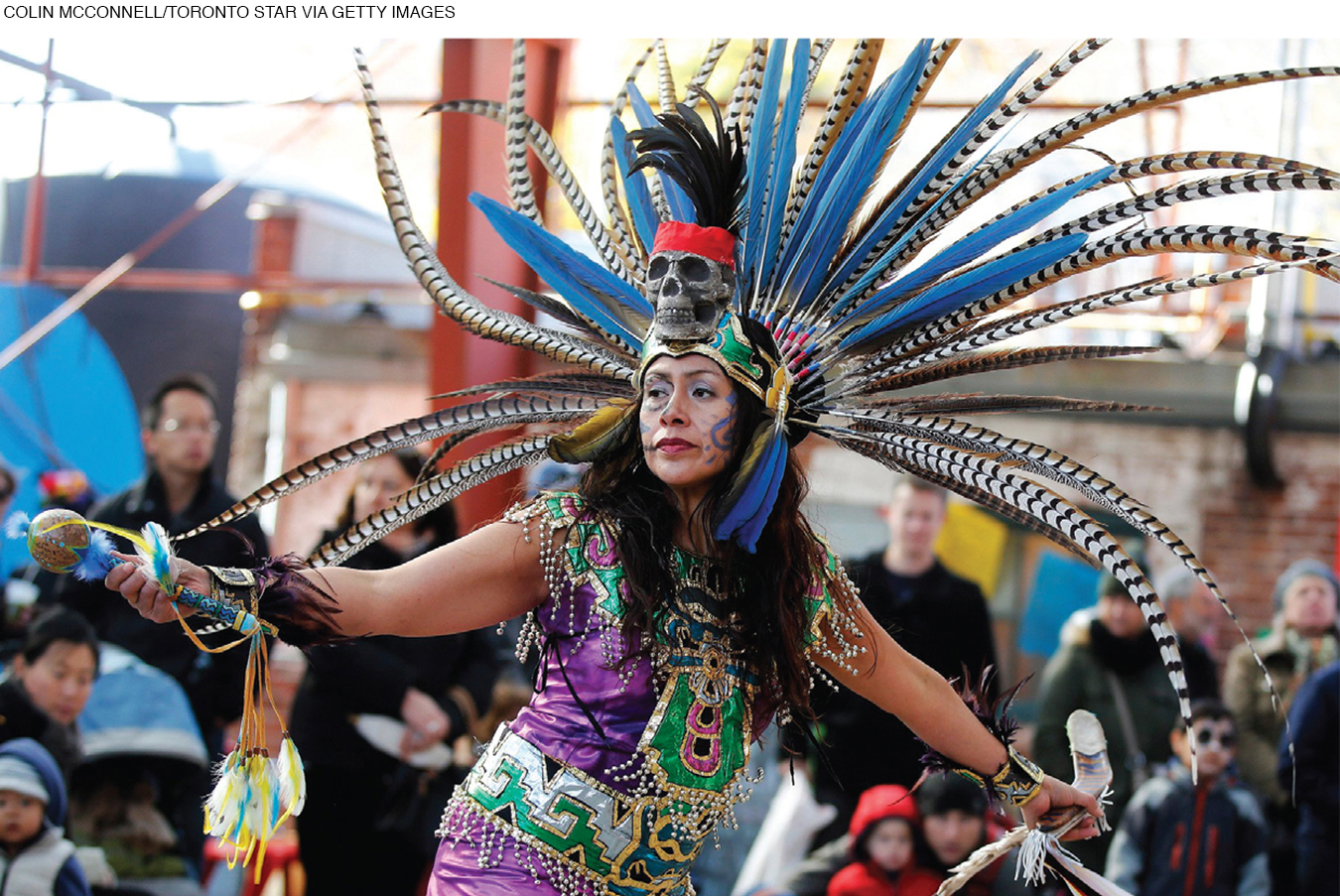
Question 16.1
OBSERVATION QUIZ
Is this in Mexico?
No, in Canada. Note the coats on the curious spectators.
Some details illustrate this diversity. According to one expert, in Hinduism the casket is always open, in Islam, never (Gilbert, 2013). In many Muslim and Hindu cultures the dead person is bathed by the next of kin; among some Native Americans (e.g., the Navajo) no family member touches the dead person.
Specific rituals vary as much by region as by religion. In North America, Christians of all sects often follow local traditions. Similarly, each of 500 Native American tribes has its own heritage: It is a mistake to assume all have the same customs (Cacciatore, 2009).
According to many branches of Hinduism, a person should die on the floor, surrounded by family, who neither eat nor wash until the funeral pyre is extinguished. By contrast, among some (but not all) Christians, the very sick should be taken to the hospital; if they die, then mourners gather to eat and drink, often with music and dancing.
Diversity is also evident in Buddhism. The First Noble Truth of Buddhism is that life is suffering. Some rituals help believers accept death and detach from grieving in order to decrease the suffering that living without the deceased person entails. Other rituals help people connect to the dead as part of the continuity between life and death (Cuevas & Stone, 2011). Thus, some Buddhists leave the dying alone; other Buddhists hover nearby.
Religious practices change with historical conditions. One example comes from Korea. Koreans traditionally opposed autopsies because the body is a sacred gift. However, Koreans value science education. This created a dilemma, because medical schools need bodies to autopsy in order to teach. The solution was to start a new custom: a special religious service honoring the dead who have given their body for medical education (J-
Autopsies create problems in the United States as well. Autopsies may be legally required and yet considered religious sacrilege. For instance, for the Hmong in Southeast Asia, any mutilation of the dead body has “horrifying meanings” and “dire consequences for . . . the spiritual well-
Ideas about death are expressed differently in various cultures. Many people believe that the spirits of ancestors visit the living, but how and when that happens varies by culture. Spirits are particularly likely to appear during the Hungry Ghost Festival (in many East Asian nations), on the Day of the Dead (in many Latin American nations), or on All Souls Day (in many European nations). People from none of those traditions sometimes believe that their dead family member came to them in a dream.
Consequently, do not get distracted by death customs or beliefs that may seem odd to you, such as mummies, hungry ghosts, reincarnation, or hell. Instead, notice that death has always inspired strong emotions, often benevolent ones. It is the denial of death that leads to despair (Wong & Tomer, 2011). In all faiths and cultures, death is considered a passage, not an endpoint, a reason for families and strangers to come together.
Understanding Death Throughout the Life Span
Thoughts about death—
DEATH IN CHILDHOOD Some adults think children are oblivious to death; others believe children should participate in funerals and other rituals, just as adults do (Talwar et al., 2011). You know from your study of childhood cognition that neither view is completely correct.
Very young children have some understanding of death, but their perspective differs from that of older people. They may not understand that the dead cannot come to life again. For that reason, a child might not immediately be sad when someone dies. Later, moments of profound sorrow might occur when reality sinks in, or simply when the child realizes that a dead parent will never again tuck them into bed at night.
Children are affected by the attitudes of others. If a child encounters death, adults should listen with full attention, neither ignoring the child’s concerns nor expecting adultlike reactions (Doering, 2010). Because the limbic system matures more rapidly than the prefrontal cortex, children may seem happy one day and morbidly depressed the next.
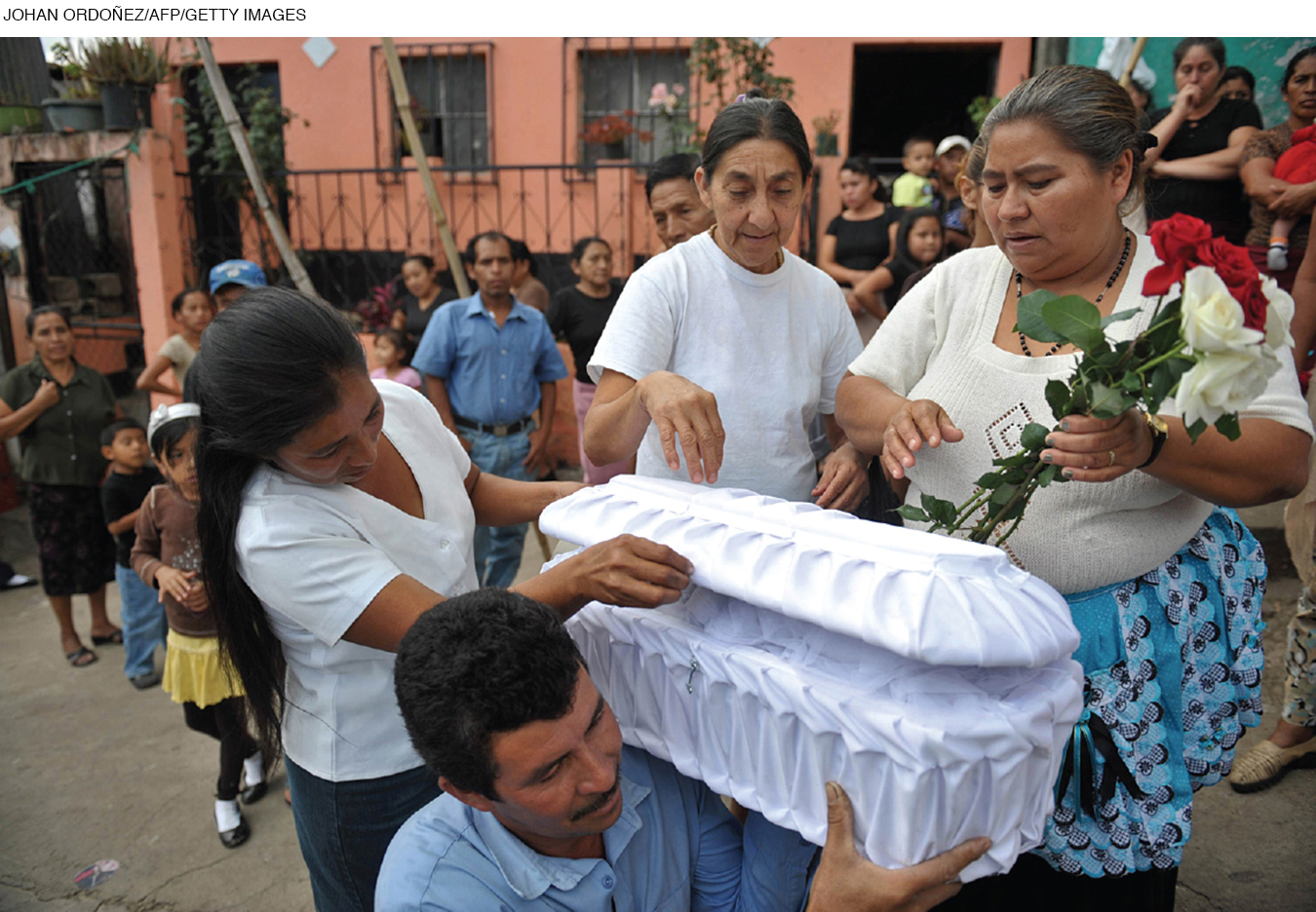
Young children who themselves are fatally ill typically fear that death means being abandoned (Wolchik et al., 2008). Consequently, parents should stay with a dying child, holding, reading, singing, and sleeping. A frequent and caring presence is more important than logic. By school age, many children seek independence. Parents and professionals can be too solicitous; older children do not want to be babied. Often they want facts and a role in “management of illness and treatment decisions” (Varga & Paletti, 2013, p. 27).
Children who lose a friend, a relative, or a pet might, or might not, seem sad, lonely, or angry. For example, one 7-
Because the loss of a particular companion is a young child’s concern, it is not helpful to say that a dog can be replaced. Even a 1-
If a child realizes that adults are afraid to say that death has occurred, the child might decide that death is so horrible that adults cannot talk about it—
Remember how cognition changes with development. Egocentric preschoolers (discussed in Chapter 5) might fear that they, personally, caused death with their unkind words.
As children become concrete operational thinkers (Chapter 7), they seek facts, such as exactly how a person died and where he or she is now. They want something to do: bring flowers, repeat a prayer, write a letter. The boy whose dog died went back to school after his parents framed and hung a poem he wrote to Twick. Children see no contradiction between biological death and spiritual afterlife, as long as adults neither lie nor disregard the child’s concerns (Talwar et al., 2011).
DEATH IN ADOLESCENCE AND EMERGING ADULTHOOD As you learned in Chapter 9, adolescents may be self-
“Live fast, die young, and leave a good-
terror management theory
The idea that people adopt cultural values and moral principles in order to cope with their fear of death. This system of beliefs protects individuals from anxiety about their mortality and bolsters their self-
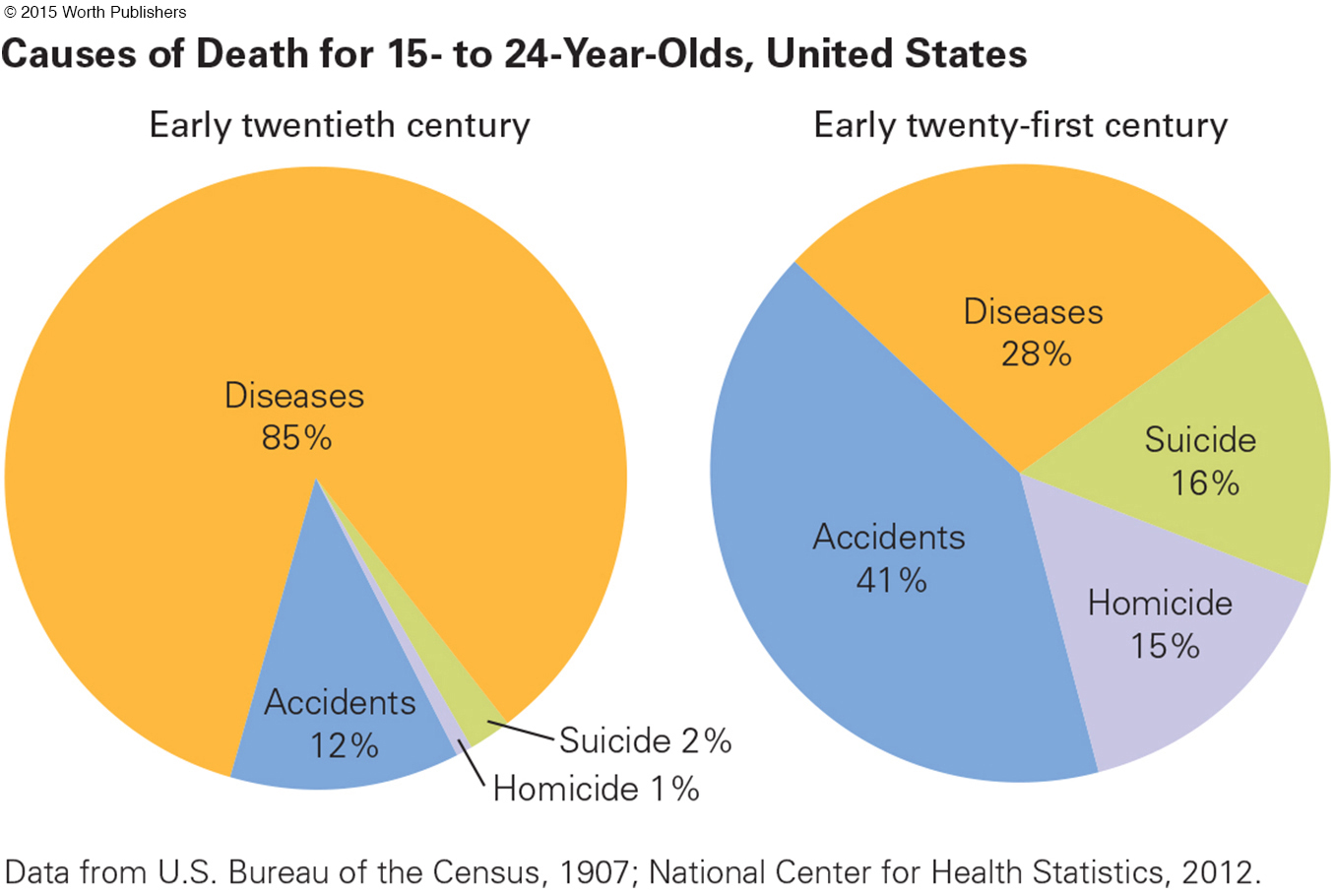
Terror management theory explains some illogical responses to death, including why young people take death-
Many studies have found that messages about the deadly consequences of smoking may provoke smokers to increase their consumption (Arndt et al., 2013). One study found that college students who were told that binge drinking is sometimes fatal were more willing to binge, not less so (Jessop & Wade, 2008). Thus, teenagers and young adults may protect their pride and self-
Other research in many nations finds that when adolescents and emerging adults think about death, they sometimes become more patriotic and religious but less tolerant of other worldviews and less generous to people of other nations (Ellis & Wahab, 2013; Jonas et al., 2013). Apparently, as people try to manage the terror of death, they try to convince themselves that loyal, conscientious members of their own group (including themselves) are especially worthy of living (Pyszczynski et al., 2015).
DEATH IN ADULTHOOD When adults become responsible for work and family, attitudes shift. Death is not romanticized. Many adults quit addictive drugs, start wearing seat belts, and adopt other death-
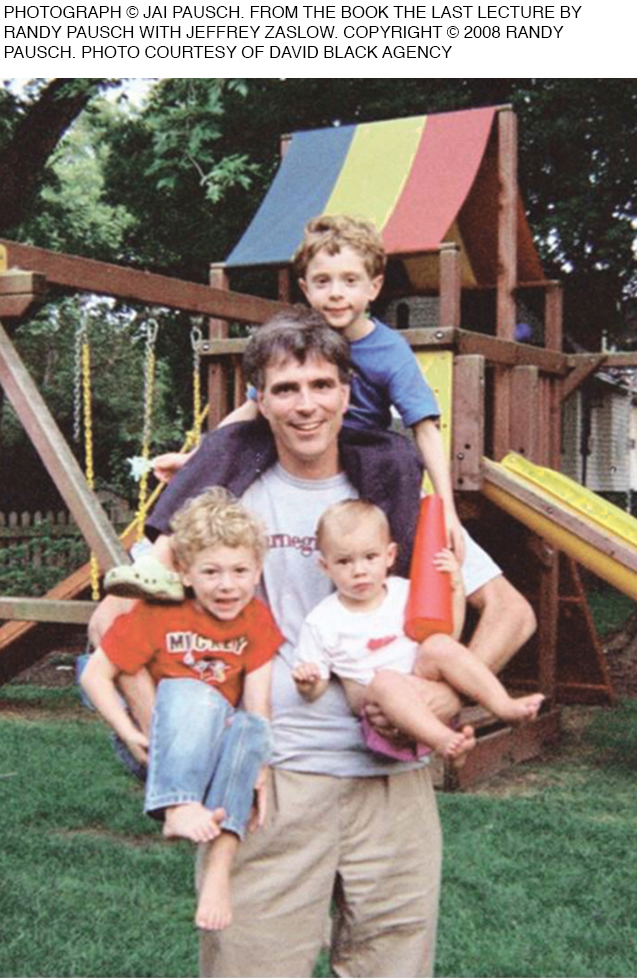
To defend against the fear of aging and untimely death, adults do not readily accept the death of others. For instance, when the inspired poet Dylan Thomas was about age 30, he wrote to his dying father: “Do not go gentle into that good night/Rage, rage against the dying of the light” (Thomas, 2003, p. 239). Nor do adults readily accept their own death. A woman diagnosed at age 42 with a rare and almost always fatal cancer (a sarcoma) wrote:
I hate stories about people dying of cancer, no matter how graceful, noble, or beautiful. . . . I refuse to accept I am dying; I prefer denial, anger, even desperation.
[Robson, 2010, pp. 19, 27]
When adults hear about another’s death, their reaction depends on the dead person’s age. Death in the prime of life, especially when caused by the person’s own actions, is particularly disturbing. Michael Jackson, Whitney Houston, and Robin Williams were mourned by millions, in part because they were not yet old (48, 60, and 63, respectively). Older entertainers who die of natural causes at age 70 or later are less mourned.
Reactions to one’s own mortality differ depending on developmental stage as well. In adulthood, from ages 25 to 65, terminally ill people worry about leaving something undone or abandoning family members, especially children.
One dying middle-
Adult attitudes about death are often irrational. Logically, adults should work to change social factors that increase the risk of mortality—
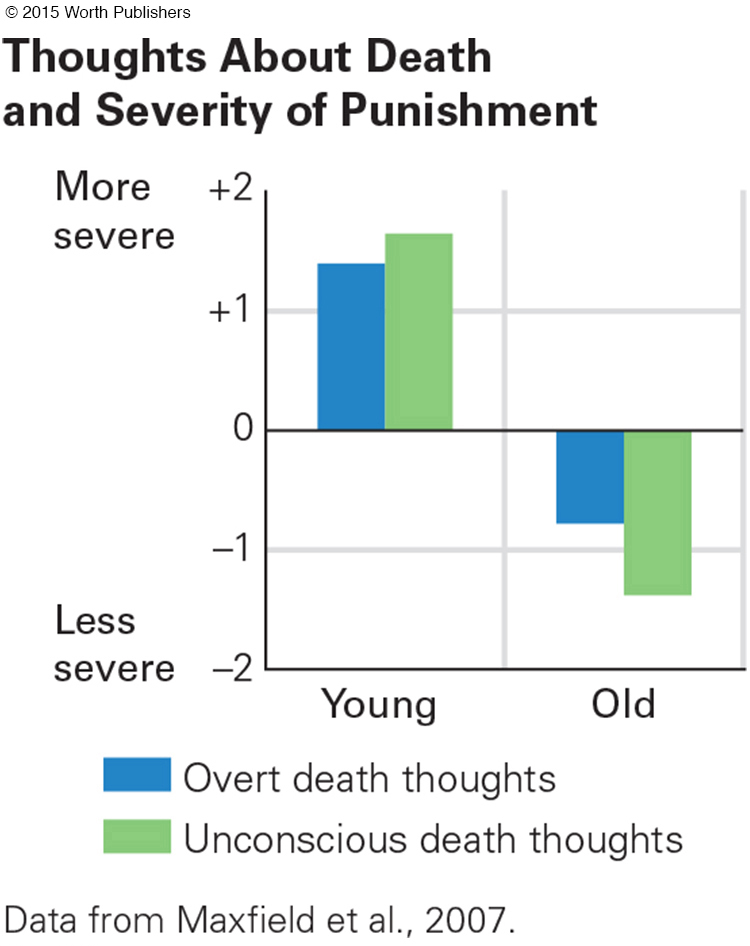
For example, people fear traveling by plane more than by car, because passengers know they personally have no control over the flight. In fact, flying is safer: In 2013, only 265 people in the entire world died in airplane crashes, compared to 32,719 killed by motor vehicles in the United States alone (National Highway Traffic and Safety Administration, 2014). The year 2014 was an unusually high one for airplane fatalities (1,320), but that was less than 1 percent of the deaths worldwide from cars and trucks.
Ironically, in the weeks after September 11, 2001, when a terrorist attack included the deliberate crash of four planes, many North Americans drove long distances instead of flying. In the next few months, 2,300 more U.S. residents died in motor-
DEATH IN LATE ADULTHOOD In late adulthood, attitudes shift again. Anxiety decreases; hope rises (De Raedt et al., 2013). Life-
Some older people are quite happy even when they are fatally ill. Indeed, many developmentalists believe that one sign of mental health among older adults is acceptance of mortality, which often increases their concern for others. Some elders engage in legacy work, trying to leave something meaningful for later generations (Lattanzi-
As evidence of this attitude change, older people seek to reconcile with estranged family members and tie up loose ends that most young adults leave hanging (Kastenbaum, 2012). Some younger adults are troubled if their parents or grandparents allocate heirlooms, discuss end-
Question 16.2
OBSERVATION QUIZ
Which seems more powerful, conscious or unconscious thoughts about death?
Unconscious. Young adults became more punitive; older adults more forgiving.
Acceptance of death does not mean that the elderly give up on living; rather, their priorities shift. In an intriguing series of studies (Carstensen, 2011), people were presented with the following scenario:
Imagine that in carrying out the activities of everyday life, you find that you have half an hour of free time, with no pressing commitments. You have decided that you’d like to spend this time with another person. Assuming that the following three persons are available to you, with whom would you want to spend that time?
A member of your immediate family
The author of a book you have just read
An acquaintance with whom you seem to have much in common
[adapted from Carstensen, 2011, p. 113]
Older adults, more than younger ones, choose the family member. The researchers explain that family becomes more important when death seems near.
This is supported by a study of 329 people of various ages who had recently been diagnosed with cancer and a matched group of 170 people (of the same ages) who had no serious illness (Pinquart & Silbereisen, 2006). The most marked difference was between those with and without cancer, regardless of age (see Figure EP.3). Attitudes change when death becomes more likely.
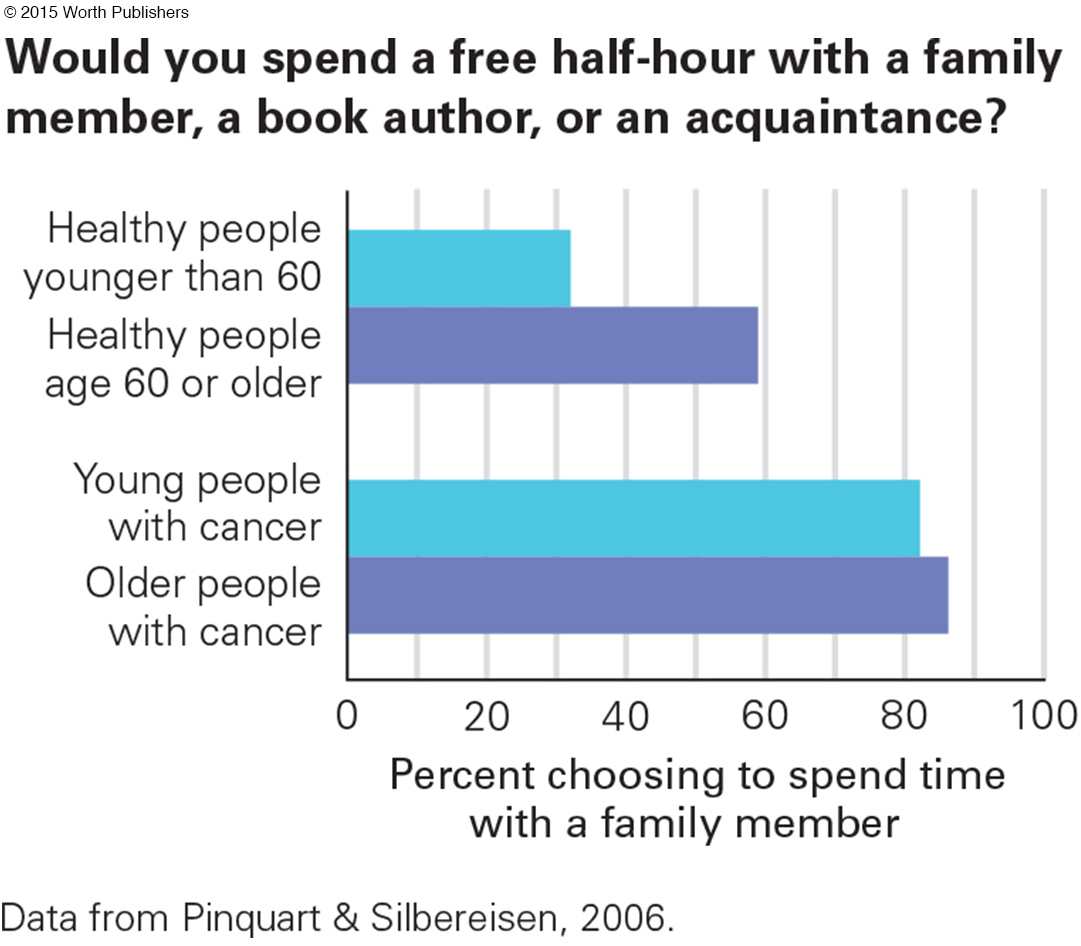
Near-Death Experiences
Even coming close to death may be an occasion for hope. This is most obvious in what is called a near-
I was in a coma for approximately a week. . . . I felt as though I were lifted right up, just as though I didn’t have a physical body at all. A brilliant white light appeared. . . . The most wonderful feelings came over me—
[quoted in Moody, 1975, p. 56]
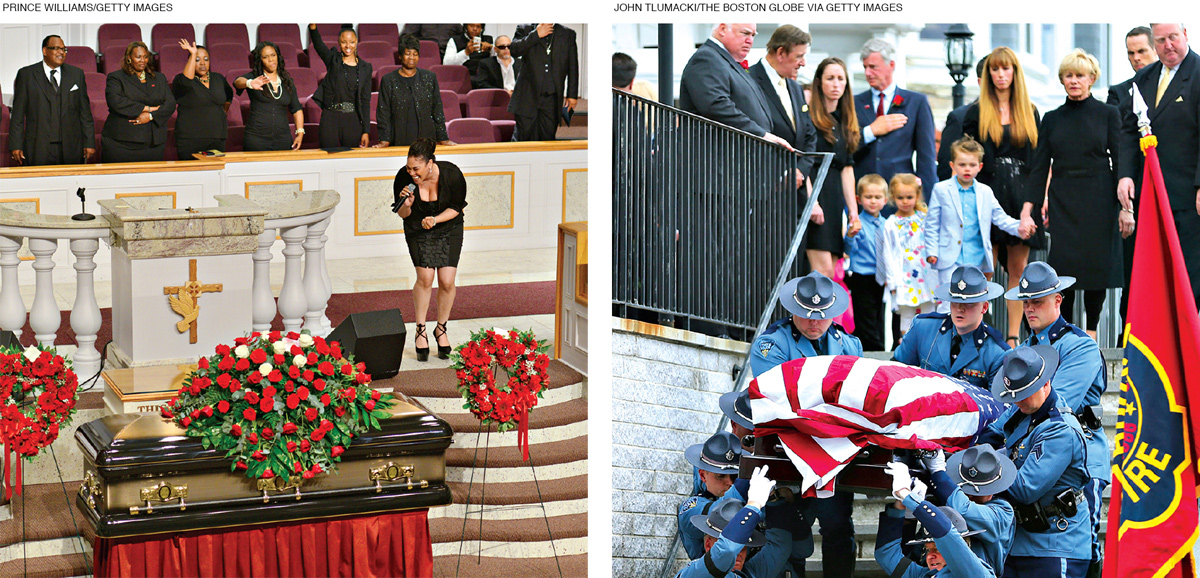
Question 16.3
OBSERVATION QUIZ
What three similarities do you see in these funerals?
Clothes, symbols, and ritual respect. In both, the mourners wear black, the coffins are draped with symbols (flags and flowers), and respect is conveyed in a manner appropriate for each—
Near-
Most scientists are skeptical, claiming that
there is no evidence that what happens when a person really dies and “stays dead” has any relationship to the experience reported by those who have recovered from a life-
[Kastenbaum, 2012]
Nevertheless, a reviewer of near-
WHAT HAVE YOU LEARNED?
Question 16.4
1. Why are people less familiar with death today than they were 100 years ago? What impact might this have?
One hundred years ago, death often took place at home, where the dying person was surrounded by family and friends. Today, death most often occurs in hospitals, removed from the view of everyday life. As death has become less familiar, it has become more feared.
Question 16.5
2. According to the ancient Egyptians and Greeks, what determined a person’s fate after death?
The ancient Egyptians believed that one’s fate after death was dependent on a combination of the person’s actions during life, the circumstances of the death, and the propriety of the burial. The ancient Greeks believed that fate after death was dependent on the good and evil deeds a person committed while alive.
Question 16.6
3. What is one example of contrasting rituals about death?
Multiple examples appear in the text. One example is that in many Muslim and Hindu cultures, a family member bathes the dead person’s body, while in some Native American traditions, no family member is to touch the body.
Question 16.7
4. What should parents remember when talking with children about death?
Adults should consider a child’s stage of cognitive development when talking about death and should strive to answer honestly. Usually the death of a person or a pet closely involved in their daily lives has more of an impact than the death of a relative who is generally removed. Avoiding the topic may give the impression that death is too terrible to even discuss.
Question 16.8
5. How does terror management theory explain young people’s risk taking?
Terror management theory helps explain some apparently illogical responses to death. With this in mind, young people may take extraordinary risks and then, when they survive, feel as though they have “proven” that they will not die.
Question 16.9
6. How does parenthood affect people’s thoughts about their own death?
When people become parents, they often eliminate many risk-
Question 16.10
7. How do attitudes about death shift in late adulthood?
In late adulthood, anxiety about death decreases while hope increases. Many older adults express a belief in life after death. Priorities shift as well; many elderly people seek to allocate more of their time to their family.
Question 16.11
8. In what ways do people change after a near-
After having a near-